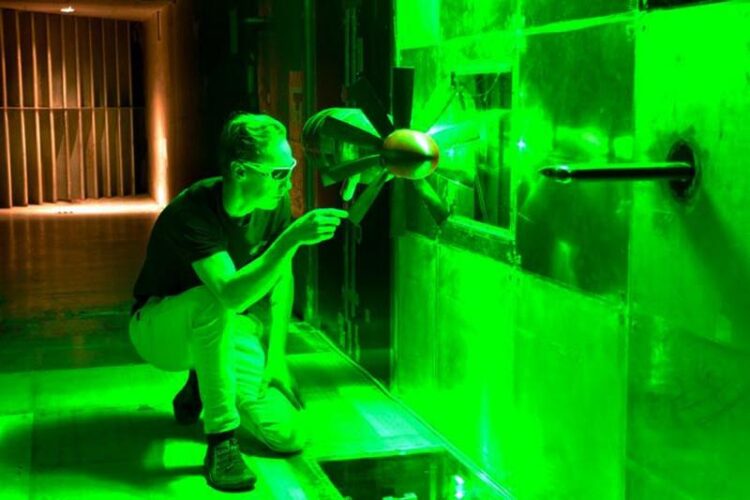Development of quieter vertical lift aircraft

A researchers prepares for particle image velocimetry measurements of unsteady inflow into a rotor inside the test section of Virginia Tech’s Stability Wind Tunnel.
Photo courtesy of Nathan Alexander for Virginia Tech
NASA grant funds aeroacoustic research…
As noise levels in urban spaces swell, a multi-university partnership seeks to turn down the volume on urban air mobility vehicles.
Drone delivery is rapidly taking off in major cities, with rotor-powered rideshares not far behind. The convenience promised by electric vertical take-off and landing vehicles generates a substantial buzz – not just from excitement but from all the noise generated by rotors filling the sky.
To address key challenges facing the future of air transport, NASA has awarded $5.7 million to a multi-university partnership as part of the agency’s University Leadership Initiative.
The project, led by Boston University over the next three years, will bring together researchers and engineers from Virginia Tech, Embry-Riddle University, Tuskegee University, and industry partner Joby Aviation to focus on developing quieter vertical lift air vehicles.
Advanced or urban air mobility concept vehicles are typically electric vertical take-off and landing, commonly called eVTOL, vehicles with four or more rotors. The grant will support research into the technical and environmental challenges of flying in urban environments.
Added convenience, added noise
As populations in urban areas continue to grow, increased traffic and industrial activity is causing cities to become louder and louder. Factoring in new modes of transportation, such as vertical lift air vehicles, will contribute to already existing noise pollution.
The research will develop methods to better predict low noise operations of such vehicles within the urban canyon. The research team will explore how much the ingestion of large-scale disturbances during flight, such as gusts of winds, will affect rotor noise.
“This is a complicated problem,” said W. Nathan Alexander, assistant professor in the Kevin T. Crofton Department of Aerospace and Ocean Engineering. “While a helicopter has one main rotor, these vehicles have multiple rotors. This provides additional degrees of freedom to control sound through individual rotor RPM and tilt, but it also makes the problem more complex. The goal is to determine the optimal configuration for safe operations in unsteady environments that also produce low noise.”
Both computational and experimental methods will be used to satisfy the research objectives.
Virginia Tech will take point on the experimental studies and has been awarded $1.3 million from the total NASA grant. Alexander, an expert in fluid dynamics, flow-structure interaction, and flow generated noise, will team with Nanyaporn Intaratep, research assistant professor, to plan and execute testing in the Stability Wind Tunnel.
The Stability Wind Tunnel is one of the leading university-owned research facilities of its kind specializing in aerodynamic and aeroacoustic testing. In addition to low background noise, the facility boasts state-of-the-art instrumentation and unique capabilities for measuring aeroacoustic flow, such as its 251-channel microphone array and stereoscopic particle image velocimetry systems.
Working with Joby Aviation, Alexander and Intaratep will design and conduct experiments to assess the aerodynamic and acoustic performances of multirotor configurations.
The team’s experiments will focus on the rotors themselves – studying their interaction in gusty environments, and measuring the RPM, thrust, torque, and noise from a variety of angles, as well as the flow field in and around those rotors.
The data captured will help validate computational models from university partners to predict the steady state noise as well as a vehicle’s response to disturbances in an urban setting.
Throughout the experimentation phase, Alexander and Intaratep will also develop a virtual lab to increase the research’s educational impact. “Most institutions do not have a facility like the Stability Wind Tunnel,” Alexander said. “By using what we learned over the COVID-19 pandemic in delivering a meaningful, online lab experience, we will be able to offer students at our partner universities the ability to participate in real flow and noise data acquisition and processing.”
The methods and data derived from this study will be open-sourced, aiding in the industry advancement of vertical lift air vehicles. The research will also provide graduate and undergraduate students hands-on research experience related to the urban air mobility industry.
Media Contact
Suzanne Miller
Virginia Tech
suzannerm@vt.edu
Cell: 540-267-4375
All latest news from the category: Transportation and Logistics
This field deals with all spatial and time-related activities involved in bridging the gap between goods and people, including their restructuring. This begins with the supplier and follows each stage of the operational value chain to product delivery and concludes with product disposal and recycling.
innovations-report provides informative reports and articles on such topics as traffic telematics, toll collection, traffic management systems, route planning, high-speed rail (Transrapid), traffic infrastructures, air safety, transport technologies, transport logistics, production logistics and mobility.
Newest articles

Innovative 3D printed scaffolds offer new hope for bone healing
Researchers at the Institute for Bioengineering of Catalonia have developed novel 3D printed PLA-CaP scaffolds that promote blood vessel formation, ensuring better healing and regeneration of bone tissue. Bone is…

The surprising role of gut infection in Alzheimer’s disease
ASU- and Banner Alzheimer’s Institute-led study implicates link between a common virus and the disease, which travels from the gut to the brain and may be a target for antiviral…

Molecular gardening: New enzymes discovered for protein modification pruning
How deubiquitinases USP53 and USP54 cleave long polyubiquitin chains and how the former is linked to liver disease in children. Deubiquitinases (DUBs) are enzymes used by cells to trim protein…



